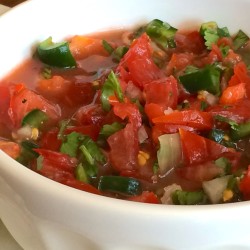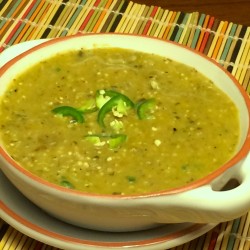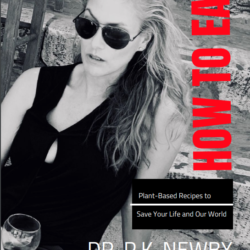Thursday, January 30, 2014
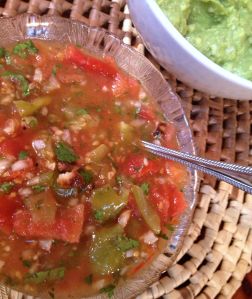 When it comes to the Super Bowl, everyone loves the game-day classics, usually including such things as chili, nachos, and pizza. I’m no different, so last year I jumped on the bandwagon with a round-up of a few of my personal favorites here. But no matter what you’re serving, I’ll go out on a limb and say chips are on the menu—which means you’re gonna need some salsa. Hey, you can even put out more than one kind to keep your buffet table as interesting as the game. Here are a few suggestions, from traditional to fruity:
When it comes to the Super Bowl, everyone loves the game-day classics, usually including such things as chili, nachos, and pizza. I’m no different, so last year I jumped on the bandwagon with a round-up of a few of my personal favorites here. But no matter what you’re serving, I’ll go out on a limb and say chips are on the menu—which means you’re gonna need some salsa. Hey, you can even put out more than one kind to keep your buffet table as interesting as the game. Here are a few suggestions, from traditional to fruity:
- Fresh tomato salsa (pico de gallo)
- Peach salsa (video)
- Tomatillo salsa (salsa verde)
- Mango salsa
- Guacamole (video)
- And yet more salsa fresca, with red and gold cherry tomatoes
(Yeah, okay, so guacamole’s not a salsa—but it otherwise fit the chips ‘n’ dip category so I tossed it in there for all you guac lovers out there.)
In today’s post, I add a new recipe to my repertoire by including roasted tomatoes and tomatillos together in one glorious dip. Unlike its summery counterpart, perfect when fresh produce is in season, this version employs roasting, a common method of cooking in the colder months that really allows the flavors to intensify. You’ll need to work a little bit harder to make this salsa then simply chopping fresh vegetables, but people always seem impressed when things are roasted—don’t they?—which is why I’ve called it “upscale.” Well, whatever. It’s quick to make, wonderful when served either warm or cold, and a perfect accompaniment to burritos, tacos, grilled fish, and other suppers
And, of course, chips.
* * * * *
Roasted Salsa with Tomatoes, Tomatillos, and Garlic
Heat oven to 450 degree F, then wash and prep the tomatoes, tomatillos, garlic, onions, and poblano pepper. (Use as many as you like, this really isn’t an exact thing, but for one frame of reference here I used 2 medium tomatoes, 7 tomatillos, 1 onion, 1 poblano pepper, and an entire head of garlic.) Peeled garlic cloves and tomatillos can stay whole; tomatoes can be cut in half if large or remain whole if small; onion and pepper get a rough, small chop. Toss all the vegetables in olive or other vegetable oil, season with salt and pepper, and place together on a pan. (More on how to roast tomatillos here.)
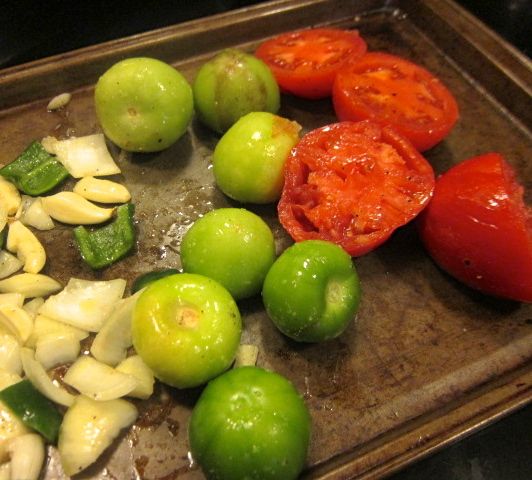
Roast about 10 minutes, then give everything a toss and cook another 7-10 mintues or so. (Time varies by size of the vegetables.) You’ll know the tomatoes and tomatillos are cooked when they are soft but still hold their shape: if a sharp knife pierces the flesh easily, they’re done; usually the tomatillos take longer, since they’re harder. For the onions, garlic, and peppers, you’re looking for a nice charring.

Chop or Blend. You now have two options. For a chunkier salsa that retains some of the distinct colors and flavors (pictured at the top), simply give everything a rough chop before adding remaining ingredients below. Or, for a more homogenous mixture, throw everything into a food processor and pulse until you obtain the texture and viscosity you desire.

The blended salsa, below, is also great, just a slightly different animal; it, too, was terrific with chips and made a toothsome topping for vegetable quesadillas when served warm. (Recipe for that dish is here.)
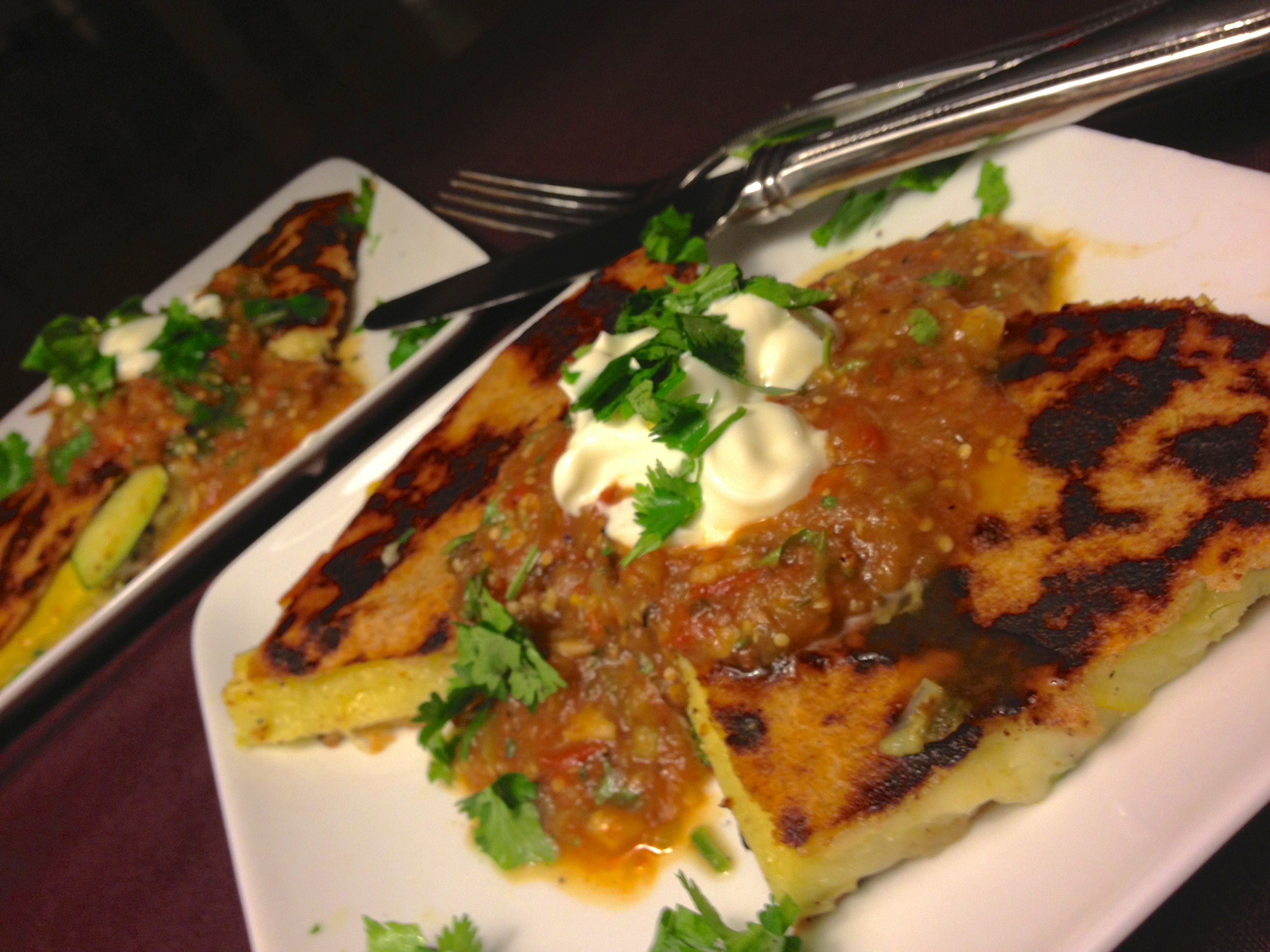
We’ve gotten ahead of ourselves, however.
Mix and stir. Whether you chop or blend your roasted vegetables, it won’t become salsa until you add the key ingredients, which are lime juice (fresh, from about 1-2 whole limes), chopped cilantro (to taste, a few tablespoons), and a bit of white balsamic vinegar (about a teaspoon or so, or less). What you’ll want to do is stir in the lime juice, cilantro, and vinegar and let it sit for a few minutes to come together before tasting. This would also be the time to include more crushed garlic and finely minced hot pepper for bolder flavors, or perhaps some additional diced raw onion for bigger bite. Sometimes salsa will also benefit from a touch of honey or agave if your vegetables weren’t sweet enough; an extra drizzle of oil can also be nice. Readjust with sea salt and freshly ground black pepper as needed to suit your palate. (If these instructions are still too vague for you, check out this video showing me salsa-making in action.)
This is a basic recipe, but don’t forget that the ultimate key to getting you into your kitchen is making things the way you like them: have fun, toss in some corn kernels, throw in some black or white beans—whatever! Plus, if you’re making your own salsa, you’ll not only impress your Super Bowl guests (or yourself), you’ll also enjoy the nutritional benefits of eating whole foods prepared with a lot less sugar and salt than if you’d bought it at the store. No packaging waste, either.
And that—to employ an obvious, not at all clever, really shouldn’t even say this yet still true turn of phrase—is definitely a touch down when it comes to your health, and the health of the planet.
—
Yeah, definitely shouldn’t have said that. Try this recipe anyway, won’t you?

